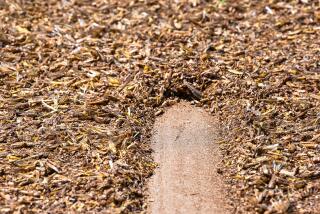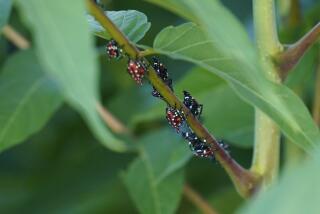Gardeners: Don’t Give Bugs a Break
- Share via
It took weeks to till all the soil and clear the dead leaves and other debris from the patch of land that--with any luck--will deliver tasty vegetables or a picturesque flower show.
But don’t get lazy now. There are a few unwelcome visitors in the garden that have to be taken care of.
That green thing hanging off the tomato plant is not a leaf. And those brown, squishy things look like they’re building a patio under the lettuce. Those pesky garden pests that were not there when the planting began are ruining all your work.
“The pests just make your plants and ornamentals a mess,” says Micheal D. Smith, managing editor of the gardening division of Ortho Books. “But there are ways to counter them.”
Thousands of insect and insect-family pests invade gardens at various times each year. Most of the tiny terrors arrive by their sensory perception--they tell plants by color, texture and fragrance--then decide if the particular vegetation is something they want in their diet.
A few pests, such as the gypsy moth and various mites, reach a garden by accident, perhaps hitching a ride under a car or truck or on a pant leg from someone’s favorite overalls.
Once in the garden, the pests can maul plants in a variety of ways--some munch away at stems, leafs and petals, others dig around plants, and some even suck and sponge away nutrients needed to keep the vegetation healthy.
Different insects, whether they invaded your garden intentionally or by accident, require different strategies to get rid of them, depending on the way they feed.
Predators are friendly insects that devour the garden-gorging pests. The beneficial insects, like the praying mantis, snail-eating ground beetle and ladybug larvae, can be imported into the garden, where they police the area for the leaf- and flower-munching pests.
Smith warns, however, that if chemicals are going to be used in a garden in addition to the predators, extra care should be taken in reading and understanding the potency of the pesticides.
“Of course, understanding the chemical pesticides is important no matter what, but in particular, you don’t want to kill off the pests’ natural predators,” he says. “You have to take care in understanding chemical pesticides.”
Other ways to combat pests include using sticky traps that catch pests as they make their way into the garden or up a fruit tree.
Another alternative is building barriers to keep crawling bugs out, but this is a time-consuming project that can involve digging trenches or wrapping aluminum stripping around the border of the garden.
There has also been research into creating pathogenic diseases that fight off and eliminate pests while not harming people, pets or wildlife. The disease germs can be introduced into the garden in ways similar to spreading chemical pesticides.
Smith says the best way to combat a specific pest is to first identify the insect by appearance--”a photo will do”--then research what the particular pest is known to eat. “From there, you can learn the best way to get rid of the pests,” he says.
But bear in mind that winning a battle against a pest doesn’t necessarily mean that the war is over.
“Pests return,” Smith says. “You have to make sure the plants are healthy. You don’t want leaves with holes in them or browning.”






